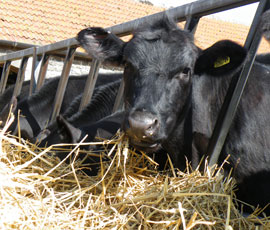VIDEO: Custom feeding to improve beef efficiency

By standardising production systems, adopting farm-specific feeding programmes, and working to reduce the age of slaughter, beef farmers can realise up to 1.2kg daily live weight gain.
This is according to Richard Phelps, founder of Blade Farming, who said by following this system, Blade Farming has reared more than 75,000 calves in the past ten years, and is on track to reach its goal of finishing 50,000 cattle a year by 2015.
Speaking at the company’s 10-year anniversary event at Barley Park Farms, Mr Phelps said: “What we do at Blade is easily achievable – it’s about following a plan. Every farm has got an individual feeding programme where we make sure they use what forage they have got, before adding minerals and supplements.
“Forage is really important – it’s the most essential feed available – so it’s important we have the right quality of grass. We have got to become more reliant on forage and forage-based products, and less reliant on cereals because of their prices.”
He said Blade follows the philosophy of finishing cattle in batches of 40 – if the pen is full, you’re managing your farm properly.
“A lot of farmers don’t realise how expensive it is to be constantly moving two to three calves to the slaughter house at a time – it’s much easier to fill a lorry with 40 animals.”
Farmers operating under the Blade system track cattle performance using EID during weigh-ins, but this can be easily done using a traditional weigh-in book, said Mr Phelps.
“The main message I would give back to producers is that anything to do with waste is actually a cost to you, but you can turn that waste into profit rather than trying to get a higher price all the time,” he added.
CASE STUDY – Barley Park Farms
Blade farmer James Hook has seen good returns from targeted feeding on his beef finishing unit at Barley Park Farms, near Witney, Oxfordshire.
Richard Phelps explains the Blade Farming philosophy at Barley Park Farms.
He is currently achieving about £100 profit a calf, with the aim of hitting 500kg liveweight between 18-20 months of age.
“All the pens in the finishing unit are designed around the Blade system – they all hold 40 cattle – and everything goes together in batches. It’s an all-in all-out system, batch by batch, so it’s easy to cost because we know every batch when they come in and have a handle on it all,” says Mr Hook.
The farm feeds a total mixed ration (TMR) with an emphasis on home-grown forage. Feeds used include round-baled haylage, chopped straw, maize silage, rolled wheat and barley, lime flour and minerals.
Due to the rising price of cereals such as rape and soya, brewer’s grains were introduced last year, and have helped produce a more palatable, slightly lower dry matter mix at a lower cost.
Mr Hook says: “We have moved to complete diet feeding using TMR rations and that has made a big difference to our costs of production – we try to use everything from the farm because we are worried about our feed costs going into next winter.”
The cattle are grouped, where possible, according to age and fed specific rations:
• Calf ration – fed from arrival until about seven to eight months of age. It consists of a higher proportion of rolled cereals and protein to suit lower intakes.
• Grower ration – consists generally of little or no cereals and low starch levels, to promote growth of frame while maintaining liveweight gain.
• Finisher ration – consists of about 20% cereals, and can also be used as a base ration to feed calves (with the addition of more cereal and protein).
“The essence of this scheme is trying to get them through as quickly as you can. The speed they grow is vital – finishing at 16 months will make money, but finishing at 20 months probably won’t,” adds Mr Hook.
In addition, he said he has benefited from monitoring and tracking performance using the EID chip system, because it has allowed him to “tinker with the feeding regime” where necessary, and do a full costing for each batch of cattle.
